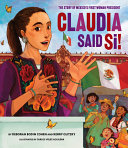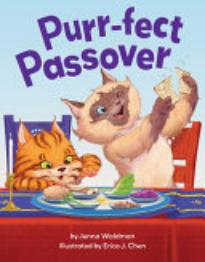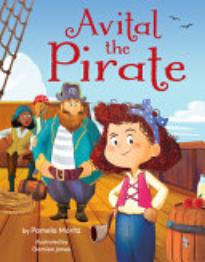Behrman/Apples
31 Reviews
(3)
K-3
Illustrated by
Carlos Vélez Aguilera.
This picture-book biography tells the story of Claudia Sheinbaum, “the first woman, the first Jewish person, and the first scientist” to lead Mexico as its president. An upbeat text balances all these aspects of Sheinbaum’s identity while emphasizing her can-do spirit. Illustrations have engagingly varied compositions, and references to mariposas (butterflies) in both text and art provide a through line. Back matter includes a glossary and brief additional background information.
Reviewer: Shoshana Flax
(3)
PS
In this series entry, human Kayla and dog Kugel bake hamantaschen, dress up as each other, and attend the megillah reading. Kayla’s explanations of the holiday, directed toward Kugel, are informative (if brief, especially about the Purim story) and interspersed with humorous asides. The community’s costumes are a highlight of the lively illustrations. An author’s note encourages discussion about Purim.
Reviewer: Shoshana Flax
(3)
K-3
Illustrated by
Cinzia Battistel.
It’s 1660, and young Yeshiva student Samuel is a part-time apprentice to famous painter Rembrandt. Rembrandt needs inspiration for a Purim scene, but finds none of the models as “courageous, faithful, and modest” as Queen Esther. Samuel recruits his sister, pleasing both his father and Rembrandt, who both newly see how the student’s faith and art can coalesce. Well-composed, inviting illustrations capture the period dress, decor, and architecture of seventeenth-century Amsterdam. Short, factual spotlights on the Purim holiday and Rembrandt’s life are appended and emphasize the Christian artist’s real-life collaboration with his city’s Jewish population.
Reviewer: Jessica Tackett MacDonald
(4)
K-3
Illustrated by
Erica J. Chen.
A family of excited cats prepares for and celebrates Passover: they clean the house, set the table, pray and sing at the seder, and eat a special meal. The singsongy rhymes and cat-themed puns (“Meow-nishtanah...” begins the cat chanting the Four Questions) can grow tiresome, but the book is faithful to the traditions of the holiday. Energetic if somewhat one-note illustrations show the kitties having a blast. Instructions for making a “meow-tzah cover” are appended.
Reviewer: Rachel L. Kerns
(4)
K-3
Illustrated by
Damien Jones.
Hanging out with a bunch of pirates sounds like more fun than doing chores to prepare for Rosh Hashanah, so Avital boards Uncle Captain Brownbeard’s ship. Aptly for the self improvement–focused Jewish New Year, she helps the crew find alternate activities to stealing and fighting, including games, shofar-blowing, and singing Rosh Hashanah songs. The story is didactic, but the pirate element and the cartoonish pencil-and-digital illustrations make for a welcome silly tale about the holiday. Brief back matter includes a glossary, author’s note, and pirate facts.
Reviewer: Shoshana Flax
(2)
K-3
Illustrated by
Carles Arbat.
An offstage narrator addresses a child who ignores the titular advice. The ursine guest helps -- and "helps" -- with preparations; the digital-looking illustrations show that, for example, picking out tiny candles isn't the best task for bear paws. Once the latkes come out, all helpfulness is out the window, and the guest is out the door. The resolution involves an outdoor sufganiyot compromise and a bear-made gift (though that tree-branch menorah might be better for decoration than for lighting). An amusing tale, speckled with Hanukkah details, about making guests feel welcome.
Reviewer: Shoshana Flax
| Horn Book Magazine Issue:
November, 2024
(2)
K-3
Illustrated by
Felishia Henditirto.
"The first problem Rochel-Leah had was that she was a girl." This picture book relates a "true(ish) story" set in a shtetl in Russia in the 1830s and inspired by a cousin of Yolen's. Rochel-Leah wants to learn to read, but the cheder, or Jewish school, is only for boys. (Her mother and aunts can't help her; her father and brothers won't help her.) But perhaps rules can be bent...with determination, an open cheder window, and a rabbi who can be persuaded. A storyteller's cadence ("It was very tiring standing on tiptoe, but she managed. Just") brings life to Rochel-Leah's frustration and her tenacity. Similarly lively illustrations, "made digitally from combining paper texture and digital brushes," propel the story forward with frequent instances of words or letters swirling across the page. An epilogue-like coda and an author's note establish family connections, and a brief glossary defines Yiddish and Hebrew terms.
Reviewer: Shoshana Flax
| Horn Book Magazine Issue:
November, 2024
(2)
K-3
Illustrated by
Fede Combi.
Lehman-Wilzig and Prinz set their story during Hanukkah 1773 in the American colonies, centering Sephardic New England Jews. Protagonist Joshua's friend Isaac and his family have meager resources to celebrate Janucá (the Spanish name for Hanukkah), but innovation from Joshua, and chocolate (an alternative to tea!) imported by Joshuas father and his crew, provide help. The Boston Tea Party actually took place on the last night of Hanukkah; the somewhat lengthy text draws connections between the colonists' "fight for freedom" and the Maccabees'. The muted palette of Combi's digital-looking illustrations lends a historic feel. Back matter provides more information about Hanukkah, the Boston Tea Party, and early American Sephardic Jews--and, of course, recipes.
Reviewer: Shoshana Flax
| Horn Book Magazine Issue:
November, 2022
(2)
K-3
Illustrated by
Greg Harlin.
Krensky's Revolutionary War–set Hanukkah tale, based on a historical anecdote and featuring General George Washington learning about the holiday from an unnamed Jewish soldier, has been modestly revised from its 2006 edition, with small edits and a new appended author's note. A Sydney Taylor Book Award winner, the story, which draws parallels between the Maccabees and the Continental Army, is illustrated with watercolor paintings both somber and luminous, reflecting the struggles for freedom--and the light of Hanukkah.
Reviewer: Elissa Gershowitz
| Horn Book Magazine Issue:
November, 2021
(2)
K-3
Illustrated by
Ben Whitehouse.
Food-truck owner Big Larry (an alligator) has always sold latkes made from Grandma Golda Gator's recipe, but this year he decides to try new flavors. The farmers' market provides options, but his peach-, turnip-, and Camembert-based latkes are each missing a key ingredient. Never fear: he comes to his senses, and the results are a delicious innovation in fusion dining. A well-metered text and friendly, cartoonish digital illustrations make for an inviting story of mixing old and new. Back matter gives brief, miracle-focused information about the holiday as well as a recipe for latkes--with fresh rainbow salsa.
Reviewer: Shoshana Flax
| Horn Book Magazine Issue:
November, 2021
(3)
PS
Illustrated by
Christine Grove.
"Today is Friday. On Fridays I wait...and wait...and wait." A boy eagerly anticipates the arrival of Shabbat as his family members grocery shop, buy flowers, do laundry, and cook. Finally, when the sun goes down and everyone sits down for a festive meal, "Shabbat is here." The cheery illustrations depict a perpetually smiling, interracial family enjoying their holiday preparations.
Reviewer: Rachel L. Smith
(3)
K-3
Koffsky retells the biblical story of Creation through the colors of each new day. "In the beginning there was nothing," and the accompanying illustrations are shades of gray and black. On day six, God created people, and "soon there were many, many more in every shade and hue." Koffsky's textural, layered cut-paper collages give readers a new perspective on a familiar story.
Reviewer: Maeve Visser Knoth
(3)
PS
"BROTHER, SISTER, / FRIENDSHIP faces, / faces of all RACES and PLACES, / we are JEWISH faces." A scrapbook-like format features bright photographs and lilting rhymes depicting the diversity of Jewish people--of various ages, skin colors, abilities, etc.--and highlighting some of their special occasions. Most of the faces are smiling ones; the "just-BRISSED" baby is (thankfully) asleep.
Reviewer: Elissa Gershowitz
(2)
K-3
Photographs by
Eliyahu Alpern.
"Did you ever wonder HOW a menorah is made?" Ofanansky spotlights three artists working with different materials to craft menorahs; she also highlights a candle-maker and explores the olive oil–harvesting process. The conversational text provides history and details about Hanukkah and presents simple tips young readers can use to make their own menorahs, dreidels, and holiday treats. Vivid photographs in a scrapbook-like format engagingly capture the hands-on details.
Reviewer: Elissa Gershowitz
| Horn Book Magazine Issue:
November, 2018
(3)
K-3
Illustrated by
Margeaux Lucas.
In 1930s Germany, women's roles were clearly defined and being a rabbi wasn't an option. But Regina Jonas charted her own path and became the first female rabbi. This powerful picture-book biography deftly addresses sexism, anti-Semitism, and changing societal attitudes. The muted illustrations depict Jonas as a powerful and inspiring figure. An afterword provides historical context.
Reviewer: Miriam Steinberg-Egeth
(4)
K-3
Illustrated by
Bob McMahon.
A prolonged case of the hiccups has Hannah worried about her solo at her school's Hanukkah program. She tries various cures suggested by a multicultural group of neighbors in her building. Nothing helps, and she performs in spite of her hiccups. On the final night of Hanukkah, while celebrating with neighbors, the hiccups stop. The story is slight but amusing; the muted-color illustrations show Hannah's family's holiday activities.
Reviewer: Miriam Steinberg-Egeth
(3)
K-3
Illustrated by
Andre Ceolin.
Jacob is devoted to his Little League team--and also to his family's practice of Judaism. When the championship game lands on Yom Kippur, Jacob is torn between whether to play ball or observe the solemn holiday. Although he does make the expected choice (synagogue), his decision-making is believably complex. Cheery illustrations show the various diverse and dynamic "teams" to which Jacob belongs.
Reviewer: Elissa Gershowitz
(4)
K-3
Illustrated by
Gina Capaldi.
Recently arrived Russian immigrant Jacob invites his new friend Benito to his family's first Passover Seder in Argentina, a meal that must overcome a few mishaps. The plot is thin, but both the text and realistic full-page gouache paintings convey the warmth of the ceremonial spring meal, and of the new friendship. An author's note discusses nineteenth-century Russian Jewish immigration to Argentina.
Reviewer: Rita Soltan
(4)
K-3
Illustrated by
Jim Starr.
Jewish giant Samson bakes an enormous challah for Rosh Hashanah and in the process creates some U.S. landmarks (e.g., his mixing bowl is the freshly dug Grand Canyon). "Big Sam" also repairs some natural environments he damaged while baking (after all, the Jewish New Year is about "mending the world") before celebrating with figures from American folklore. Lush paintings illustrate this entertaining if overtly instructive holiday tall tale.
Reviewer: Rita Soltan
(4)
K-3
Illustrated by
Beth Bogert.
Three goblins torment a town by tangling children's hair. The children, all with challah-related punny names (e.g., Franklin Frenchtoast, Dana Dipitinsoup), work together to trick the goblins and trap them in twisted dough, creating the challah. An author's note discusses challah's connection to Jewish traditions, something the twee narrative doesn't make clear. The pastel-toned illustrations give the story a dreamy, folktale-like look.
Reviewer: Miriam Steinberg-Egeth
31 reviews
We are currently offering this content for free. Sign up now to activate your personal profile, where you can save articles for future viewing.























